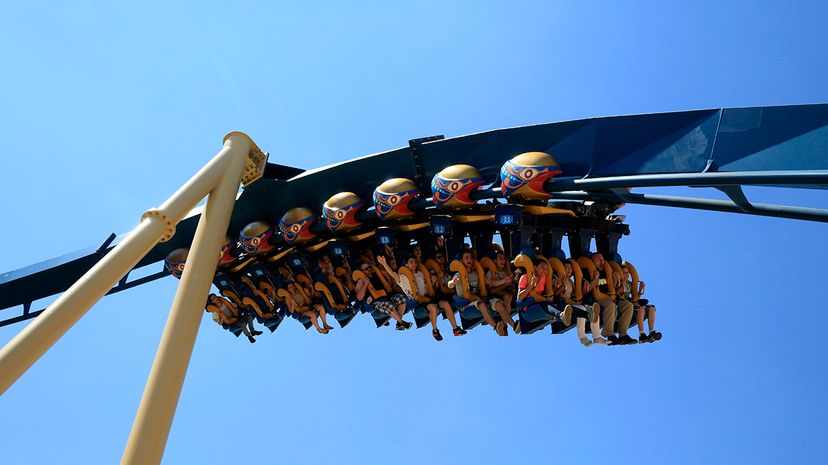Types of Roller Coasters

There are two major types of roller coasters, distinguished mainly by their track structure. The tracks of wooden roller coasters are similar to traditional railroad tracks. In most coasters, the car wheels have the same flanged design as the wheels of a train; the inner part of the wheel has a wide lip that keeps the car from rolling off the side of the track. The car also has another set of wheels (or sometimes just a safety bar) that runs underneath the track. This keeps the cars from flying up into the air.
Wooden coaster tracks are braced by wooden cross ties and diagonal support beams. The entire track structure rests on an intricate lattice of wooden or steel beams, just like the beam framework that supports a house or skyscraper.Track designers can even flip the train upside down (though this is rare in modern wooden coasters). But, because the track and support structure are so cumbersome, it is difficult to construct complex twists and turns. In wooden coasters, the exhilarating motion is mainly up and down.
Advertisement
Even though wood has its limits, which typically make wooden coasters slower and tamer than steel coasters, it also has advantages. Wooden coasters are designed to sway slightly as the train moves through them, which lends a unique effect that cannot be replicated with more rigid materials.
The range of motion is greatly expanded in steel roller coasters. The world of roller coasters changed radically with the introduction of tubular steel tracks in the 1950s. As the name suggests, these tracks consist of a pair of long steel tubes. These tubes are supported by a sturdy, lightweight superstructure made of slightly larger steel tubes or beams.
Tubular steel coaster wheels are typically made from polyurethane or nylon. In addition to the traditional wheels that sit right on top of the steel track, the cars have wheels that run along the bottom of the tube and wheels that run along the sides. This design keeps the car securely anchored to the track, which is absolutely essential when the train runs through the coaster's twists and turns.
The train cars in tubular steel coasters may rest on top of the track, like the wheels in a traditional wooden coaster, or they may attach to the track at the top of the car, like in a ski lift. In suspended coasters, the hanging trains swing from a pivoted joint, adding an additional side-to-side motion. In an inverted coaster, the hanging train is rigidly attached to the track, which gives the designer more precise control of how the cars move.
A tubular steel track is prefabricated in large, curved segments. The steel manufacturing process allows for a smoothly curving track that tilts the coaster train in all directions. A wooden roller coaster rattles as it rolls over the joints that connect the pieces of the wooden track. In a tubular steel coaster, the track pieces are perfectly welded together, making for an incredibly smooth ride. As any coaster enthusiast will tell you, each sensation has its own distinctive charm.
According to the Roller Coaster DataBase, there were 4,639 coasters in operation around the world in 2018 — 4,455 of them steel, 184 wooden. The RCDB identifies eight main coaster types:
- Sit-down: The traditional design, with riders sitting inside a car.
- Stand-up: Riders stand on the train's floor instead of sitting.
- Inverted: The train travels below the track instead of on top of it. It is distinct from a suspended coaster since the train is fixed to the track.
- Suspended: The train travels beneath the track, but unlike an inverted coaster, the train is fixed to a swinging arm that pivots from side to side.
- Pipeline: The track is attached to the middle of the train, instead of above or below it.
- Bobsled: Wheeled trains slide down a U-shaped tube instead of being fixed to a track.
- Flying: Riders start out in a seated position but are rotated to face the ground as the ride starts, giving the feeling of flying.
- Wing: Two seats from each car are positioned on either side of the track. The seats spin or rotate on their own axis, either freely or in a controlled motion. In 2018, there were nine Wing coasters in operation with two more under construction. This type of coaster is sometimes referred to as 4th Dimension.
Never been on a coaster before? In the next section we'll give you some advice on your first ride.